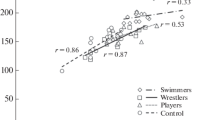Summary
Ventilatory response lines to carbon dioxide at rest were determined by the rebreathing method in 10 untrained subjects, 17 sprint swimmers, and 11 long-distance swimmers. It was found that the mean slope of the ventilatory response line of the swimmer was lower than that of the untrained group, and the mean slope of the long distance swimmer was lower as compared with the sprint swimmer, though these differences were statistically not significant. The differences in the hypercapnic drive between untrained subjects and swimmers obtained here is discussed in connection with their maximum oxygen uptake.
Similar content being viewed by others
References
Arkinstall WW, Nirmel K, Klissouras V, Milic-Emili J (1974) Genetic differences in the ventilatory response to inhaled CO2. J Appl Physiol 36:6–11
Byrne-Quinn E, Weil JW, Sodal IE, Filley GF, Grover RF (1971) Ventilatory control in the athletes. J Appl Physiol 30:91–98
Clark TJH (1968) The ventilatory response to CO2 in chronic airways obstruction measured by a rebreathing method. Clin Sci 34:559–568
Cunningham DJC (1974) Integrative aspects of the regulation of breathing: a personal view. In: Weddicombe, JG (ed) MTP International review of science, respiratory physiology. Butterworths, London, pp 303–369
Cunningham DJC, O'Riordan JLH (1957) The effect of a rise in the temperature of the body on the respiratory response to carbon dioxide. Q J Exp Physiol 42:329–345
Haywood C, Bloeke ME (1969) Respiratory response of healthy young women to carbon dioxide inhalation. J Appl Physiol 27:32–35
Hermansen L, Saltin B (1969) Oxygen uptake during maximal treadmill and bicycle exercise. J Appl Physiol 26:31–37
Lally DA, Zechman FW, Tracy RA (1974) Ventilatory response to exercise in divers and non-divers. Resp Physiol 20:117–129
Leitch AG, Clancy L, Flenley DC (1975) Maximal oxygen uptake, lung volume, and ventilatory response to carbon dioxide and hypoxia in a pair of identical twin athletes. Clin Sci Mol Med 48:235–238
Linton RAF, Poole-Wilson PA, Davies RJ, Cameron IR (1973) A comparison of the ventilatory response to carbon dioxide by steady state and rebreathing methods during metabolic acidosis and alkalosis. Clin Sci Mol Med 45:239–249
Miyamura M, Honda Y (1972) Oxygen intake and cardiac output during maximal treadmill and bicycle exercise. J Appl Physiol 32:185–188
Miyamura M, Yamashina T, Honda Y (1976) Ventilatory responses to CO2 rebreathing at rest and during exercise in untrained subjects and athletes. Jpn J Physiol 26:245–254
Miyamura M, Fujitsuka N, Matsui H (1979) Ventilatory response to hypercapnia in the monozygotic twins (in prep)
Miyashita M, Hayashi Y, Furuhashi H (1970) Maximum oxygen uptake of Japanese top swimmers. J Sports Med Physical Fit 10:211–216
Read DJC (1967) A clinical method for assessing the ventilatory response to CO2. Aust Ann Med 16:20–32
Rebuck AS, Read J (1971) Patterns of ventilatory response to carbon dioxide during recovery from severe asthma. Clin Sci 41:13–21
Saunder NA, Leeder SR, Rebuck AS (1976) Ventilatory response to carbon dioxide in young athletes: A family study. Am Rev Respir Dis 113:497–502
Scoggin CH, Doekel RD, Kryger MH, Zwillich CW, Weil JV (1978) Familial aspects of decreased hypoxic drive in endurance athletes. J Appl Physiol 44:464–468
Song SH, Kang DH, Kang BS, Hong SK (1963) Lung volumes and ventilatory responses to high CO2 and low O2 in the ama. J Appl Physiol 18:466–470
Author information
Authors and Affiliations
Rights and permissions
About this article
Cite this article
Ohkuwa, T., Fujitsuka, N., Utsuno, T. et al. Ventilatory response to hypercapnia in sprint and long-distance swimmers. Europ. J. Appl. Physiol. 43, 235–241 (1980). https://doi.org/10.1007/BF00421837
Accepted:
Issue Date:
DOI: https://doi.org/10.1007/BF00421837



